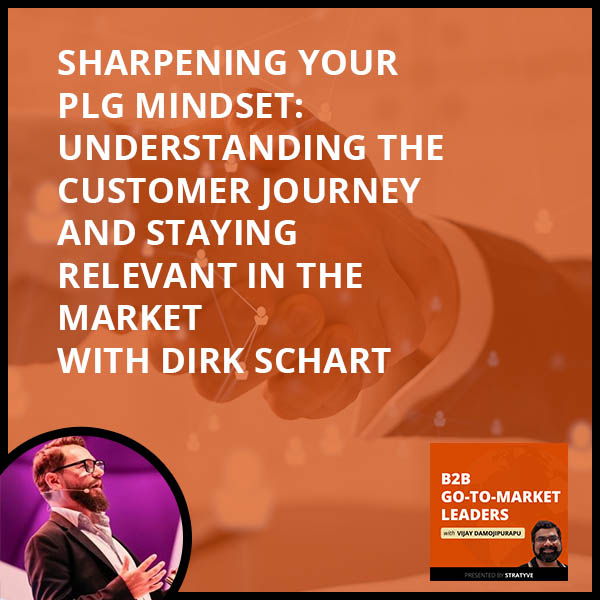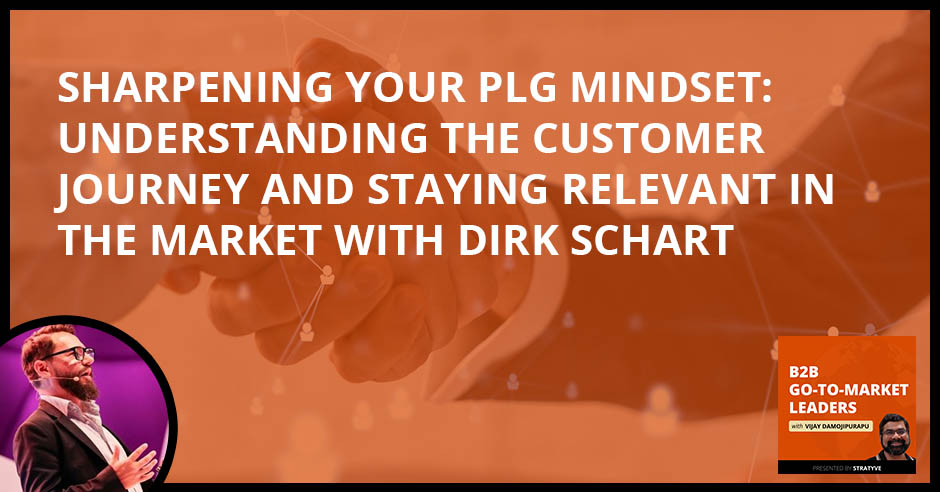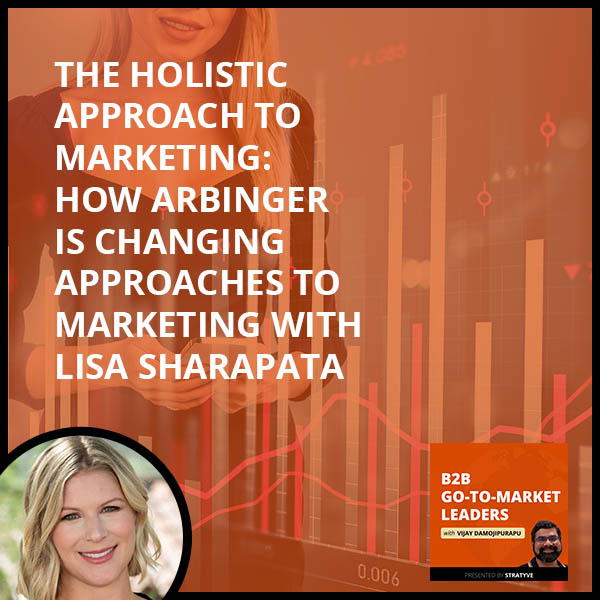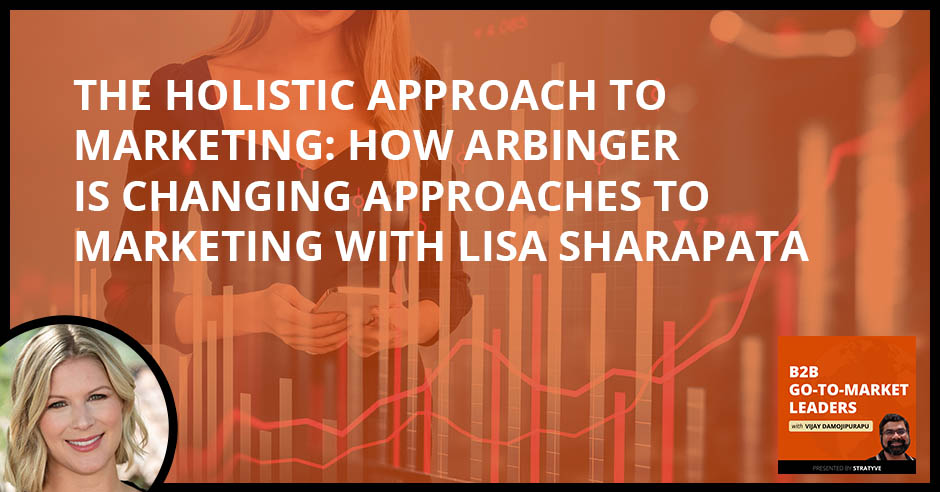

Success in go-to-market strategy and product marketing requires a deep understanding of the customer journey and a PLG mindset that prioritizes user adoption and growth. By combining different perspectives and experiences, we can build innovative approaches that drive lasting impact in the global market. In this episode, we have special guest Dirk Schart, Senior Director, Go-to-Market & Marketing at PTC. Dirk discusses go-to-market strategies and the customer journey, drawing from his experience and expertise in startups and Fortune 500 companies alike. Dirk dives deep into the PLG mindset, discussing how it has helped him succeed and how other leaders can adopt this approach. Dirk also brings a unique perspective on the global market, having a global-crossed background. Tune in now and gain valuable insights into what it takes to build successful marketing campaigns and drive growth.
—
Listen to the podcast here
Sharpening Your PLG Mindset: Understanding The Customer Journey And Staying Relevant In The Market With Dirk Schart
Welcome to the newest episode of the show. The newest can be your first, umpteenth, 5th, or 10th. I’m thankful for taking the time to check out the show where I get to meet and have a conversation with inspiring, thoughtful, and influential go-to-market leaders. I have the pleasure of meeting Dirk Schart who is a well-known and established product marketing and PLG leader. He is here with us. Welcome to the show, Dirk.
Vijay, thanks for having me.
It’s my pleasure. For the audience, Dirk is joining us from Germany. Dirk, you are the 2nd or 3rd guest who is outside the US. I’m excited about that.
That’s great. We bring a little bit of the European perspective and combine that. My background is across the globe. I grew up in Germany, but I used to live in Spain and the United States. Let’s combine all of these different perspectives.
I’m looking forward. I always start the show with this question with all my guests. How do you view and define go-to-market?
It’s a great starting question. It’s not the easiest question, to be very honest. There are so many different definitions. I want to start with this. What is important for me besides the definition is that go-to-market is a journey. It’s a loop. It’s not a one-off thing. You do something and plan something. In the past, we talked about the launch of a product. You launch it, you have the Big Bang story, and then you’re done. You go home, and that’s it, “Let’s see what’s going to happen.”
That’s not how I understand a modern go-to-market. For me, go-to-market is more the strategic plan, including the execution of activities to make a product available to its users, show the differentiated value, drive adoption, and build the basis to grow the user base. It’s that whole loop. A couple of years ago, I built a framework, not for go-to-market but more to understand how the customer journey works. That’s very similar. I call it the Five Stars. It’s how customers see our product and how they try it out and see if that works. You go into adoption, rate, and share.
Often that second or last part is cut off. We think, “We bring it to market and then back off. That’s it,” but then afterward, the adoption, the word of mouth, and the customer advocacy are where the real game starts. That’s why it’s a loop journey. That’s how I define that. I mentioned one thing, which is super important in that definition for me. Show the differentiated value. I’m sure we will come back to that, but I’ll highlight that because I hear often, “We will launch a product. It’s better than XYZ.” For me, there are no better products. Different is better than better. I’m focused on differentiated value.

That’s a great point. How you framed the go-to-market and how you started the conversation reminds me of and takes me back to my initial days of product marketing. What I’m going to share is a rookie mistake of a lot of the folks, especially within product marketing where they think they “own” go-to-market. It’s typically around, “It’s all about the Big Bang launch. We are done.” It’s a bill checklist. The sales enablement, value prop, pricing, and messaging are done, but that’s just one point in the whole customer journey. It’s an ongoing thing. What you mentioned is it’s not a once-and-done thing. It’s a continuous evaluation or iteration process of keeping the buyer and user journey in mind.
You highlighted a very important point there. You said the product folks owned it. I’ve seen many companies where sales own it. When people talk about go-to-market, they mean sales. One of the big things here is to combine them. It’s marketing, product, sales, customer success, and engineering. All of these different departments have to come together to make that go-to-market plan a reality. It’s important.
You nailed the premise of this show and what I’m trying to do on LinkedIn and all the different channels. Go-to-market is not owned by one function. It’s an amalgamation. It’s a collaboration effort. It takes the entire cross-functional team, starting with the product and going on to the marketing side, the sales, the customer success, and not just that. You’re also talking about the executive or the leadership. It’s all of these things. To your point, the previous start that I was at, when people talked about go-to-market, it’s sales. How do you take a product to a market and sell it? It’s all about sales, but then the definition or the view has to expand.
That’s also how I understand marketing. My background is in different areas. I have experience in sales where I started my career in marketing. I was also in the role of a product owner. That helps a lot to understand how these different business functions work if you’re responsible for different things. You can leave that bubble you’re in as a marketer often. What do sales need? How does the product build that thing? What are their challenges? What do we have to do to bring all of that together?
It’s exciting if you can get all of the people engaged, motivated, and passionate about an upcoming launch. It’s one of the best things you can have. You should not forget the customers. They also can be involved in that go-to-market process, not at the end of it and say, “Customer, that’s what you get,” but have them involved before, ask them for feedback, have a better face, and stuff like that. There are a lot of different people involved.
We can go on and on about this one topic and one question. It’s a good segue into the next piece. Share with our audiences your career journey, your personal and professional milestones, what brought you to the place, and who you serve.
My background is in marketing and communication science, which influenced my marketing career a lot. The way I see marketing and the way I do marketing is about perception and how people perceive different things. That’s where my background is. I lead the global go-to-market and marketing for PTC‘s Vuforia business. PTC is a Fortune 500 company based out of Boston. Vuforia is a business that builds augmented reality solutions for manufacturing companies.
Marketing is a lot about perception. It’s understanding the different perceptions of people. Share on X
I joined PTC as part of an acquisition. I was working for a startup called RE’FLEKT where I was a CMO. I built our US business based out of the Bay Area. We became part of PTC. It’s a very interesting experience to see how that works. I’m now bringing all of the experience from what we have together with what the PTC folks do. It’s great learning from both sides.
Before that, I was with Hyperloop, Elon Musk’s transportation project where I was in a mix of a product and a marketing role. I built their European hub in the SaaS business. There are many interesting things. In the augmented reality business, we patented a technology that is called Augmented Windows. That’s super interesting. It lets you look outside of the windowless Hyperloop capsule with head motion, capturing cameras, and stuff like that. It’s very interesting.
Before that, I was at a corporate. I started my career in sales. It’s broad, not a typical IC type of marketer, which helps me a lot. I call always a business marketer a person who has a different understanding of different segments and knows how to run a business, which helps me a lot. Whenever I have some time left, then I mentor startups for the German Silicon Valley Accelerator, especially startups coming from Europe and going to the United States. I’m helping them to understand what is different in marketing and sales. That market is so different from what Europeans do. I love new challenges, different startups, and different products. That’s my background.
It’s pretty diverse. You started in sales business dev, worked in non-tech companies initially, and then moved into tech. Having Hyperloop on your resume and background is a cool conversation starter in social settings and parties. The fact that you were a CMO of the startup which got acquired by PTC says the breadth, depth, and good market expertise that you bring to the table.
It helps a lot with understanding how the other functions work. I was with different industries, especially with Hyperloop. Hyperloop is a technology company. That’s how it is defined. It’s building a transportation system, working on the software side for it, and redefining completely what a customer experience can look like in the future. That’s not only a fun project because it was one of the most interesting projects in the last couple of years. It’s an unbelievable and super-talented team. That was great. There’s the acquisition of joining PTC with all the experienced people there and combining our startup experience with that. I’m thankful for having the opportunity to go through all of that. It’s great learning.
Let me double-click on something. I don’t know if it was Elon Musk who was on the interview team or maybe some of his leadership who was part of the interview process for you. Prior to your role at Hyperloop, you were the Head of PR and Marketing at RE’FLEKT. It has nothing to do with products and such but then you were hired as a product manager. What stood out? What did the folks see in you? What attracted them?
I worked with Hyperloop before. We also had a project together with RE’FLEKT and Hyperloop. The Hyperloop leadership knew me and hired me as a leader to build a team from scratch, open the European hub, and bring that whole thing to life. It was less about going into any product details. It was much more about building a team and building the strategy for what product we need and what is needed to make that happen. That’s what they saw when they worked with me. I built that for RE’FLEKT and other companies. Plus, Hyperloop is an LA-based company coming from California.
I had experience at that time working in different countries in Europe but also in the United States. That was the reason that they said, “We want to have a leader that can build that whole thing and has the experience on how to figure out what the market needs and what the problems are.” That’s the marketing part of customer discovery because it was very early. What exactly do customers expect in the future from a Hyperloop app? What is needed? How can we change that whole market? Some of these things are still in stealth mode until Hyperloop was released and built. That’s why they hired me.
It’s that inquisitiveness and curiosity and having that open mindset. Even though you didn’t call out any of these explicitly, I can sense it. Coming from an augmented reality startup that’s very tech-oriented and maybe more selling to B2B versus Hyperloop, the audience is the consumer. It’s different. How did he go about that mindset shift?
First of all, for me, everything is about learning. I’m a lifelong learner. I always want to learn new things. One of the things I’m quite good at is diving into new topics quickly, understanding how things work, and then making it happen. The other thing that is very interesting point is the discussion about B2B and B2C. For me, in marketing and also other areas, B2B and B2C are not far away from each other as some people might think. When I started the first B2B company, I said, “We don’t need user experience because that’s B2C. We are here in B2B.” For me, it’s always about taking B2C things into B2B and the other way around.
Everything is about learning. Share on X
We have different audiences, and they have different expectations, but coming back to my favorite topic of perception, at the end of the day, we’re all humans. The guy who sits in procurement in B2B companies or who is a decision maker in training or a service department or wherever in the marketing department, at the end of the day, it’s a human being. That’s it. We all have the same way to make decisions and the same structure. Some are more visual. Some are more factual, but at the end of the day, it always comes back to perception.
That’s why in that switch between B2B and B2C, there are specific areas. If you’re looking for an expert on how to do eCommerce or Google Ads for different things, that might be different, but in building the strategy and executing the go-to-market plan, there are many elements you find in B2C and B2B. That’s good. I love to take B2C stuff to B2B because I don’t like when people build a go-to-market for B2B, and it’s boring. We don’t need all of these exciting things because we’re a B2B company.
They say, “I know,” but now imagine the guy who makes a decision and writes a check. That guy goes home in the evening. She or he will then have an Amazon app to order stuff, DoorDash to order food, Netflix, and all of that great stuff. Why should they have the boring stuff at work? I don’t see that. You mentioned PLG at the beginning. PLG is bringing B2C to B2B. That’s for me the essence of what we do. Finally, we’re targeting the users, not only the buyers, and coming top-down and bottom-up in not only one thing.
We share a lot of thought processes. That’s what attracted me to PLG, even before the fact this whole PLG became a fad in the last couple of years. PLG at its core and essence is about how you connect the dots between the end user and the product. It’s simple. There’s nothing in between. How do you help them see the value quickly within a couple of days or a week ideally? If not, you lose them. That’s the essence.
There’s a lot in it. It’s because we also had that discussion at PTC. How much of that can we use? We’re coming from enterprise software. We’re now on a journey or a transition to SaaS software. Our customers are manufacturing companies. How much of that can we use? What I often like to say is there’s one thing to implementing a pure PLG strategy, but the other thing which I try to show my teams is to use the PLG mindset. It’s what you said. You have that product. Focus on the end user.
This is a different way to think about it. It’s a different persona. That’s something we realized back at RE’FLEKT when we started to turn one of our products into a more bottom-up and PLG approach. It’s about the mindset. Think about it. What can you do to reach that user? What can you do to make that user happy and change the user’s habits to use something new, not the existing solution anymore? That’s what it is about. It’s changing habits, and that’s not easy.

On a lighter note, how would your family describe what you do at work?
That’s an interesting one. I had that conversation with my son. He asked me, “What are you doing all day long when you are on these calls?” I said, “I’ll show you. It’s better showing than telling a story here.” He plays Roblox. One day, he came and said, “There is an option to create assets like t-shirts and then sell them.” I said, “I’ll show you what I do in my job.” I helped them and said, “This is how you figure out which shirts the people like there. You don’t create something because you like it. It’s not about you. It’s about the folks there.” You find a nice way to explain it and show it. You have a nice booth there in Roblox. I said, “I’ll take that sign. You go around and make people aware of it.”
I showed him the whole thing. He sold a couple of shirts. Was he more successful because of me? I don’t know. He probably was smart enough to figure it out without me, but in the end, he said that I help people to find products and make people understand why they’re helpful in a very simple way. That’s how I showed him and how he explains it. He probably says it differently in his words. It’s much nicer than I can do as a boy.
There’s nothing that beats the whole teaching and showing experience. In this case, your son gets it and applies those lessons in a Roblox virtual environment.
I love it. The cool thing is they sit in front of that thing all day long if you don’t stop them, but at least I said, “He has to learn something. I want to see an outcome there.” That’s why I now do these things with him. I said, “Where can we learn something?” I bought a couple of Roblox shares so that he can see and follow, “Does it go up? Does it go down?” He reads the news and stuff like that. He gets an understanding of what’s behind all of that. That’s important that the kids learn that.
That’s a great insight and a great way in how you are teaching your son. You’re applying and helping him see products, marketing, and “sales” also. You need to sell that product eventually. You’re helping him realize and see those concepts for himself. That’s pretty cool stuff. Switching gears and going into your current role at PTC, can you briefly describe what you do? What is your charter? What are you responsible for at PTC?
My team and I plan the go-to-market and all the marketing activities for Vuforia. Vuforia is PTC’s augmented reality business, building work instructions for manufacturing companies in a visual way. We bring the products to market. We help with the content, the thought leadership, and all the typical marketing activities. AR is still an early technology. It’s a little bit different from what you have when you do marketing automation software or a CRM where everything is already clear. The value is proven. The value propositions are clear.
It’s more about, “Which one of these? Do I need Salesforce? Is HubSpot better for me?” We have a different situation. We are early in the market and still in a transition from early adopters to mainstream markets, which brings different challenges. Besides the typical go-to-market, we are a lot in understanding how that transition is happening, what the customers need, and how the buyer’s journey is changing. All of these things are covered by my team.
Who are the customers? Who are you going after? Going after is a very wrong term, but who are you focusing on in this?
A typical customer profile is larger manufacturing companies, automotive machinery, and MedTech. It’s all these companies building machines, cars, medical devices, and all of these things. The profiles are different. We have three different audiences or target groups. The first one is the buyer. They’re typically executive-level. We have what we call the creator. These are the people who create these instructions and manuals.
The third one is then the frontline worker who is what we call the end user. Different audiences make it a little bit more challenging for us because we need to understand who needs what in a journey, what problems they have, and what formats we have to deliver, educate, and show what they can do with our products and solutions and how we help to solve the problems in the manufacturing industry.

What are your typical KPIs? What are you and your team measured against?
At the end of the day, it’s always the same thing. It’s revenue. For me, that’s important. We don’t go only in smaller metrics and say, “How many people read our newsletter and stuff like that?” Revenue is the first one. The pipeline is the second one. They measure not only what the marketing source is but we are looking into what is the impact of our activities and how we help sales to generate pipelines and to win new customers. A lot of our strategies are ABM-focused to target very specifically.
That’s important. In AR, you can do a lot of different use cases there. Customers expect us to help them and guide them through these use cases and then tell them which ones work best. That’s why we’re very focused there. Everything around adoption, retention, and NRR is a very important metric. The net revenue retention rate and customer satisfaction with NPS are the high-level metrics. You can see it goes from acquisition to retention and customer satisfaction. That’s important for us.
We’re focused, especially because AR is a very specific topic. What can we do on the retention side and the adoption side to have happy customers? Coming to the P&G, the B2C mindset, and all of these things, we ask our customers to share the message, rate our solutions, give us rankings, and all of these things so that they help us to market our products, not only closing the loop after we sold.
These are the typical metrics. We go down and look into things around account engagement. What can we do there? On the retention side, for example, we go deeper into feature adoption. What impact do our activities and campaigns have on feature adoption? I also hear a balance between acquisition and retention. We’re going further down into pipeline acceleration and pipeline quality, especially because we target very focused. For us, it’s important to see. Do we have the right personas? Do we have the right opportunities based on our use case strategy and all of these things?
I love the fact that your emphasis is across the entire customer journey, unlike many or most of the marketing teams who are focused only on top of the funnel building a pipeline, and that’s about it. This is where your background and thought process comes into play. It’s not just about getting folks in as a salesperson. As a business dev, you saw that piece, but then once you started going into the product side of things and working closely with the customers, getting a customer in is one touch point.
In the end, how are you helping them see the value and adopt the various features of the product? As they’re adopting, where are they? How are they rating it? Are they satisfied? That’s where the NPS comes into play. The NRR is eventually, “Are they churning? Are they expanding? What about it? How are they eventually helping spread the word? Are they evangelists evangelizing on your behalf?”
It’s all about making the customers happy and showing them value. That’s why I talked about differentiated value at the beginning. What do we do differently? Why should customers come to us and buy our solutions, not use the existing solutions or another solution? Why do they have that differentiated value? When you have the adoption and get that right, then the engine is starting to run. That’s a traction point there.
On the other side, for sales, it’s super important that we help with coming to that point and that we help with expansion. Instead of only chasing new logos, we all want to have new customers. There’s no question. They’re great customers and companies we want to have, but we’re super happy to have the ones we have already in our portfolio. We want to make sure they have everything to scale and grow.
We focus on the programs we run. That’s the goals we defined for 2023. It’s simple. A) We make it easier for our customers to understand the value and what they can do with our solutions. B) We make it easy for our sales and customer success teams to expand customers, win customers, and provide the value the customers expect. It’s all about making it easier for customers and our teams.
I’m sure across your journey, you’re seeing both go-to-market success and go-to-market failure stories. I’m sure it’s more of failures, and those are the learning experiences. Can you share one success story and one failure story? We can tease more details as we go along.
I’ll start with a success story. The first one is brand new. It’s what we did at PTC when we started what we call the use case-based approach. In AR, you can do a lot of different use cases. The technology is very broad, but customers are using visualization technology, especially in different areas. It might change in a couple of months, and it might change in a couple of years completely. That’s why we said, “We focus on specific use cases where we got feedback from our customers. The impact is the biggest.”
On the other hand, we saw the adoption data and usage data. We came up with the concept to focus on specific use cases. The great thing here is it’s not only the success in terms of how much market share we win and how many customers we win. For me, the biggest thing is the alignment we got from leadership, product, marketing, sales, and customer success. Everyone knows the use cases. Everyone knows why we have them, which business problems we solved, and what the value is. It’s an easy one.
I said, “You get everything because we have everything to market, sell, and expand, whatever you need.” You don’t see that alignment very often. Usually, there are discussions, “Not that. We need to go in a different direction.” Let’s say it’s a marketing discussion. In the end, they do different things. That’s one of the things where I say, “That’s great.” I’ll take learning before I come to another successful one. We did exactly the opposite back at RE’FLEKT where we said, “We’re a startup. We can do it.” We tried to serve too many use cases in all industries at the same time. Why? It’s simple. As always, it’s because of the fear of missing out. We said, “There, we see something. Here, we see something. There is a signal.”
“Let’s throw something at the wall and see what sticks.” That’s a mindset.
Plus, we were so convinced about what we can do as a small startup that we had the idea to even add a partner program. We were not ready at all. Our customers or the technology wasn’t ready to be sold through that channel. We were not ready. That was a big learning in the go-to-market. Stay focused. Avoid the fear of missing out. It’s not going to help you. You can make any of these areas and industries happen. At the same time, you can make any of the marketing channels happen.
Avoid fear of missing out. It's not going to help you. Share on XThere are companies that use events or SEO. You can make all of them happen if you focus on it and have the experience and expertise. That’s a learning I took from the fear of missing out and being too early with offering a broader scope. That cost us a lot of time until we repaired it. That’s something I can only recommend avoiding, especially for startups. It’s not only a startup thing. I see that also in larger companies. They have more resources, but it is often very blurry. The strategy is not clear.
Here’s the last thing. We talked about the P&G before. We had two products at RE’FLEKT. One was a typical enterprise product and one, which was very simple, was a remote support tool. During the pandemic, there was a lot of demand. What we did is we used the P&G mindset. We did not even know exactly how that works. We tested it and said, “We need to come up with a concept that targets the users.” We talk to the users now. That’s what we did. Our team was involved in the product and said, “We understand why they want to have that and why they need that.” It’s a completely different way to think.
In the end, we had 300% more trials and better conversion rates, but the best thing, and what I never forget is customers were happier because we had 30% to 40% fewer support tickets. They found all the documentation. They got a different onboarding. They didn’t need to wait. They had everything ready. That was a huge shift in our strategy. That’s why I said, “We did it as a typical enterprise AR startup.” That’s a great learning of what you can do if you have that mindset.
These are great success and failure stories. I want to double-click on that failure story that you shared. You emphasized one point, which is the fear of missing out. The subconscious mind drives people, the marketers, the leaders, and the sales folks, “Let’s go after this industrial segment. Let’s go after this manufacturing segment. Let’s go after this new territory or new geography. It’s not just the US but even Germany, Australia, Canada, and all the English-speaking countries.”
That’s where we run the risk of spreading ourselves way too thin. We don’t know if we’re addressing the buyer in manufacturing versus a user in Australia. It’s completely different. Coming back to your success story, you said, “The formula for success was focusing on certain use cases.” Did you have to educate the cross-functional team and the leadership, “Let’s not spread ourselves too thin and focus on only these use cases,” or everyone was aligned starting from day one?
The process was quite smooth, to be very honest, but the reason for it was that we did our homework in positioning. What I have seen a lot in my career is that companies, especially startups don’t spend enough time working on positioning. It’s the same thing. They think it’s a one-off thing. You do it and spend an hour, and then it’s done. It’s not. It’s one thing I always tell the startups. I mentor that this is something you can learn in Silicon Valley. That’s what startups get right in the Bay Area.
Focus on your positioning. What exactly is your market? Where is your differentiated value? What is the right profile behind that? When you understand that, then you will figure that there are specific use cases or replication fields of customers where you see signals and indicators for growth. That’s exactly what we did. We could have never done that only as a marketing team. There’s no way that you can change a strategy that significantly.
The reason was that we realized we are the market leader. PTC is the market leader in that area. We can serve all of these customers, but the question is not about, “Can we make all of that happen?” We can. We have enough people, but how can we provide the most value to our customers? Our customers expected us to understand, “Where can I use that technology best? What are the best use cases? How can I do it? How can I bring that change to my company?”
That was the starting point for us. We listened to the customers. We need to guide them. We are the guides helping them to make it happen. That’s how we built that strategy and got customer feedback. We had the customers, and then it was a very easy one. We said, “A) We have our data. B) This is what the customers are telling us.” All of us were involved. When the sales were involved, the product was involved. All of them understood that.
For products, it’s much easier to build features, define features, and define a roadmap if they know this is our focus, not that. Otherwise, they have to build everything for everyone. They were thankful for that. It’s the same for customer success and sales. We have a situation when we say, “Do we need to add more use cases? What other use case do we add?”
Sales also want to have more new stuff. That’s a normal thing. That’s okay also because sales get always feedback from the market and are very close to the customers. The positioning was the foundation, showing what the customers want and expect from us as a market leader. We have a different role from what we had as a startup before. As a market leader, you need thought leadership and category leadership. You need to provide guidance. That helped us a lot to build that together with the customers.
Going back to the basic, which is data, that comes from talking to the customers and showing that to the customers.
It’s as easy as that, but it’s not.
Going into the final segment here, now I see that you’re pretty active in terms of publishing your views on go-to-market, product marketing, and PLG. You’re carving out time in broadcasting. Those are top-of-mind for you. How do you stay on top of all these things and carve out time to even create content?
That’s another fear-of-missing-out challenge. First of all, I love books. I read a ton of books. It’s a little bit challenging because I love to read several books at the same time. I cannot wait. There are a couple of books I read over and over again like Behind the Cloud by Marc Benioff of Salesforce. I can only recommend reading that. I recommended that to my team. There’s Trillion Dollar Coach by Bill Campbell if it comes to leadership, but also things like high-tech marketing. There’s Crossing the Chasm by Geoffrey Moore to understand how the markets evolve and change. That’s one thing.
The second thing is talking to people. I love talking to people. That’s why I love to be part of the Peak Community and all of the folks there because you meet people from different backgrounds. Communities and talking to customers are big things for me. Podcasts for me are part of the books. I do my daily walk usually at lunchtime and then listen to podcasts.
The last thing is mentors. I have mentors. I always had mentors, and I have mentors now who help me to challenge things, bring things back, and remind me of things where I think, “I thought that was great. It wasn’t.” That’s an essential part for me. I want to learn. That’s also the culture I built for my teams. Failures are allowed. I encourage everybody to make mistakes. That’s the only way to learn and improve things. These are the things I do.
Failures are allowed. Make mistakes. That's the only way to learn and improve things. Share on X
That’s pretty cool stuff. I love the fact that you’re constantly looking for ways to learn and stay on top using books and communities like Peak Community. You and I are part of the Peak Community. Here’s a shout-out to Peak Community. For you as an audience, feel free to reach out to me or Dirk. We will share more insights into how and why you need to be part of the Peak Community.
Besides Peak Community, you also talked about podcasts. While you walk, you listen to podcasts. There’s something else that you hit upon, which is mentors and folks who helped you shape your thinking and the process, which you thought was the right way but then it was not. Who are the 1, 2, or 3 folks that you are grateful for, and who shaped your career and the person you are now?
I’ll mention 1 or 2 that you would not expect. They’re not mentors but people I admire. They did something very special in their business. The first one is Jimi Hendrix. There are a couple of guitars here in the background. Music, heavy metal especially, is important to me. Jimi Hendrix took guitar play to the next level by doing things nobody did before. There are a lot of examples of what he did, which always reminds me of not even thinking outside of the box. It’s thinking without a box. It’s leaving the comfort zone. How can you define your style? That’s something you can do in guitar playing, but that’s what you also can do in go-to-market or marketing. What is your style? What is important for you?
That’s one thing. The second is Steve Jobs. Probably many people say that, but for me, he was a master of simplifying things. He could simplify a message everybody understands. That’s unbelievable. When you read my stuff, you will often see the rule of three. People already know me. My team also knows that. That’s our perception. How does our brain work and stuff like that? I have had many mentors over time. I have mentors now and mentors in the past. There’s one guy I want to call out. Tom Rice is a mentor in the Bay Area. Tom helped me so much when I started in the United States where I was CMO.
I built our business with his brutal feedback and so much good advice. I could have not built the business I built without his advice. I remember one time he invited me to dinner and asked me how is it going. He had to listen to a 30-minute complaint, “It’s not working as I expected. This is not working there.” In the end, he said, “I’m not going to ask you that question anymore. The next time, I will ask you how your family is.” I got it. That’s good to have mentors like Tom.
Here’s the final question. If you were to turn back the clock and go back to day one of your go-to-market journeys, what advice would you give your younger self?
Focus. It’s as easy as that. It sounds simple. It’s not because of the fear of missing out, but that’s what I tell everyone. When I think back, we did a startup of 15 people trying to implement 15 marketing channels. There’s no way to handle it. It’s about focusing on one thing. Make it great.
Those are pretty strong parting words. Thank you so much for your time, Dirk. Good luck to you and the team at PTC. We will cheer from the sidelines for your success.
Thank you. I appreciate it.
Important Links
Love the show? Subscribe, rate, review, and share! http://stratyve.com/





